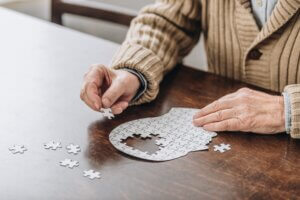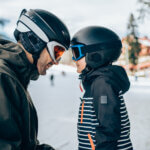Exercise & Fitness
A Heads Up on Brain Injuries
March is a month of awakening – not just for nature, but also for traumatic brain injury awareness. Did you know that in the United States alone, there are more than 5.3 million individuals, both young and old, living with permanent brain injuries? It’s a staggering number that underscores the importance of understanding and addressing this critical health issue.
Step into Aspen Valley Hospital’s emergency department, where you’ll witness over 2,000 patients seeking care for head injuries every year. Recognizing a growing need for coordinated care for head injuries a decade ago, AVH pioneered initiatives in brain injury rehabilitation for our community, becoming one of the most extensive and highly regarded programs of its kind on the Western Slope.
Thanks to the dedication of our compassionate staff and an administration focused on providing the Roaring Fork Valley with comprehensive care and education, two pivotal programs emerged to address the need: the Traumatic Brain Injury (TBI) Program and the Helmet Program. Over the years, these programs have not just taken root but flourished, continuously evolving to address the pressing concerns surrounding brain injuries.
Empowering Recovery: The TBI Program
 In 2014, with the help of AVH Occupational Therapist Krista Fox, the TBI Program took flight, empowering physicians, therapists, trainers and others with cutting-edge practices in managing both adult and pediatric patients. Understanding the intricate nature of brain injuries, AVH adopted a holistic, team-based approach to rehabilitation, marked by an unwavering commitment to personalized treatment strategies to ensure better outcomes for patients.
In 2014, with the help of AVH Occupational Therapist Krista Fox, the TBI Program took flight, empowering physicians, therapists, trainers and others with cutting-edge practices in managing both adult and pediatric patients. Understanding the intricate nature of brain injuries, AVH adopted a holistic, team-based approach to rehabilitation, marked by an unwavering commitment to personalized treatment strategies to ensure better outcomes for patients.
These individualized treatment programs include regular visits to the program’s home base at the Hospital’s campus in Aspen, daily exercises at home and, typically, collaboration among the program’s different therapists, as well as other hospital and community resources. Each member of our team of Certified Traumatic Brain Injury Therapists has specialty training in neuroanatomy and neuroplasticity and the medical, physical, psychosocial and neurocognitive issues that accompany TBIs. In all, five therapists at the Hospital carry this certification and represent different disciplines, so they can closely coordinate care for our patients. There are three overlapping areas of these disciplines:
- Physical therapists treat balance, whiplash, orthopaedic injuries, vertigo and vision impairments.
- Occupational therapists treat cognitive, vertigo and vision impairments.
- Speech/language therapists treat cognitive impairments.
Do you know the signs of a brain injury?
We are an active community, and brain injuries are a concern for anyone leading an active lifestyle. While brain injuries are largely activity related, they are also caused by car accidents, falls and work injuries. Brain injuries can be incredibly complex. If you or someone you know has suffered a brain injury, here are some of the impairments you should look for:
- Visual
- Emotional
- Cognitive
- Balance
- Cervical or neck pain
- Sleep disturbances
- Changes in activity tolerance
Prevention: A Vital Step Forward
While the journey of rehabilitation is transformative, prevention remains the cornerstone of our efforts. Through our Helmet Program, we’re steadfast in our mission to educate and equip our community with the knowledge and tools to prevent brain injuries. The majority of head injuries seen in AVH’s emergency department are largely activity related, and wearing a helmet can be the key difference between life and a life-changing injury. From skiing and snowboarding to mountain biking and beyond, our program offers a diverse array of helmets tailored to various sports and activities. We also stock helmets in the Hospital’s emergency department, so staff can give them to patients on an as-needed basis.
Spearheaded by Trauma Program Director Jill Kennedy, RN, BSN, our outreach extends beyond the hospital walls, integrating with local events and initiatives like Bike to Work Day, Aspen Valley Ski and Snowboard Club’s 4th of July Picnic, and the National Ski Patrol Safety Month’s on-mountain events. Jill also helps with injury and fall prevention, so our community can safely explore everything the Roaring Fork Valley has to offer, at every stage of life.
Simple Steps for Helmet Safety

- Find your size: Try on helmets to find the one that fits best. Many have dials in the back that allow adjustments. It should fit snuggly. People with a ponytail should be aware that it changes the way your helmet fits.
- Helmet positioning: The front of the helmet should be one or two finger widths above your eyebrow. If you are helping someone else, be sure to use their fingers.
- Side straps: The helmet’s side straps should form a V with the bottom just below the ears. They can be adjusted by changing the length of the chin strap.
- Chin strap: The left side of the chin-strap buckle should be centered under the chin. When clicked together with the right side of the chin strap, it should fit snuggly so that it does not slide backwards or side to side.
As we enter spring ski season and we eagerly anticipate the joys of summer, let’s not forget to safeguard our most precious asset – our brain. Whether you seek information on AVH’s Traumatic Brain Injury Program or need assistance in acquiring or fitting a helmet, our doors are open to you.
For more information on AVH’s Traumatic Brain Injury Program, call 970.544.1177. To access a helmet or learn more about TBI prevention, call 970.544.1576.


